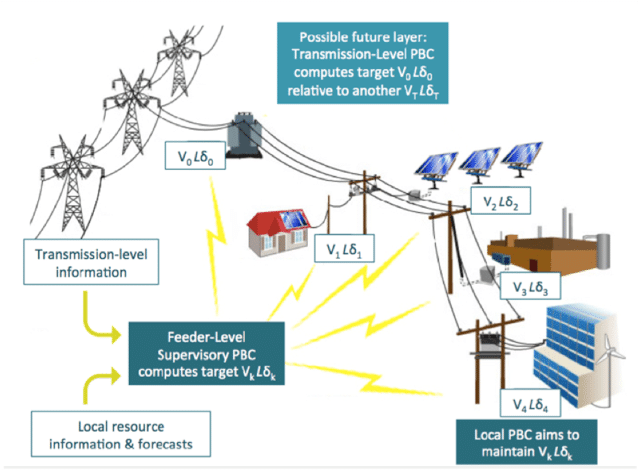Electric Grid
Phasor-Based Control for Scalable Solar PV Integration
Phasor-Based Control (PBC) is a radically new layered control framework for managing high penetrations of solar and other variable energy resources on electric utility distribution circuits. This project integrates several threads of research and development including high-precision micro-synchrophasor (µPMU) measurements, analytics relating phasor profiles to dynamic and unbalanced power flows, decentralized adaptive control algorithms, and simulation capabilities to effectively characterize large networks.
This project demonstrated that solar PV can be recruited to stabilize the grid, smooth out disturbances, manage power flows, and assist circuit switching operations. It developed a radically new, layered control framework for Distributed Energy Resources (DER) to act in response to real-time, measured conditions on their local distribution circuit, rather than waiting fora price signal to indicate preferred behavior. By enabling resources to act as good citizens on the electric grid, Phasor-Based Control (PBC) facilitates arbitrarily high solar penetration levels.
PBC expresses objectives in terms of voltage phasors, which include information about both the magnitude and the precise timing of grid voltage at each specific location. A supervisory (S-PBC) controller sets voltage phasor targets at different nodes in the transmission or distribution network, and local (L-PBC) controllers recruit real and reactive power from resources such as solar inverters, batteries or loads to track phasor targets. The technology makes use of ultra-precise measurements from micro-phasor measurement units (μPMUs).
Phasor-based control prioritizes stabilizing the grid locally, toward operating states known to be safe in accordance with physical operating constraints, while buying time for economic re-optimization after major changes or contingencies. In doing so, it advances grid reliability and resilience. The framework supports many diverse use cases that specify desired voltage phasors at certain nodes. It applies to distribution as well as transmission systems, although this project focused primarily on distribution applications and simulation. Sample use cases tested in this project include power flow control, voltage management, phase balancing, and support for switching operations.
Key Project Accomplishments include the following:
- Built a repository of non-proprietary test circuit models.
- Demonstrated that supervisory phasor-based control can produce phasor targets consistent with optimal power flow objectives, using suitable linearization techniques.
- Demonstrated that local phasor-based controllers can be effectively tuned to recruit distributed resources for tracking a target phasor and reject disturbances.
- Built a novel communications and control infrastructure, termed the Distributed Extensible Grid Control (DEGC) platform.
- Demonstrated fast simulation capabilities for large networks using a novel partitioning strategy.
- Produced successful PBC simulations on large, realistic distribution circuits.
- Validated simulation results in hardware-in-the-loop (HIL) testing with physical μPMUs, inverters and load banks.
- Produced a value analysis for PBC based on enhanced grid security.
- Identified proliferation opportunities for PBC and infrastructure technology.
The technology is now ready to be field deployed in an experimental pilot setting.

